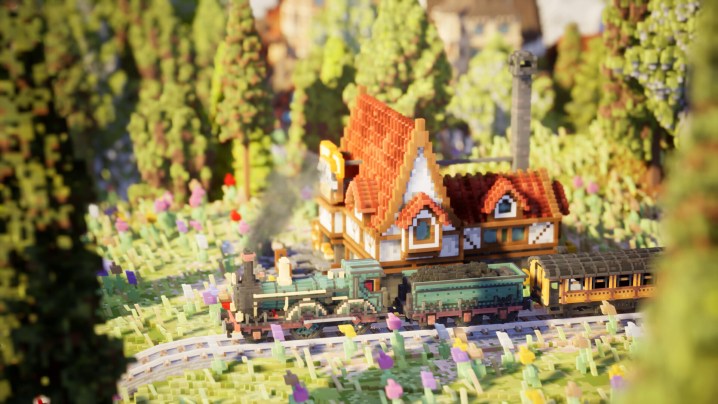Looking for a cozy fall game to settle down with this weekend? There’s a great new release out on PC now that’s perfect for the season. Station to Station is a relaxing new PC game (that’s one part minimalistic puzzler and one part railroad management simulator. It’s a laid-back indie with earthy voxel art and a gentle soundtrack, but there’s some deceptively deep strategy layer on top of that. Whether you’re just looking to chill or create complex railways, Station to Station may very much need the game you need this season.
Developed by Galaxy Grove, Station to Station asks players to create efficient railroads between various buildings dotted on a small map. It plays like a mix of Mini Metro and Dorfromantik, creating a satisfying puzzle hook that’s easy to pick up. At first, the tasks are simple. One building needs wheat from a mill nearby. I place a station next to each building and connect the two together. Simple. The more tasks I complete, the more buildings are added to a map. I may reveal a spot that can produce milk but needs wheat in order to do so. The goal of each level is to keep connecting railways until each building’s conditions are met.

It’s as intuitive as snapping Legos together, but there’s a lot of nuance that gets layered in with each level. For instance, I can take a track over a cliff by creating a bridge, but that’ll cost me a lot more money. I can sometimes get around that cost by creating anchor points in a track so it can snake around flat land, though that can get pricey too. Money is a finite resource at each level, so I always need to figure out the most cost-effective way to build a track. Every decision I make matters as I’m rewarded for smart planning.
That’s best reflected in Station to Station‘s deepest puzzle layer. If I connect my railroads in a certain order, I can move a bunch of resources between stations at once. This activates a stack bonus, giving me more money for each material delivered in a turn. To land a big payout, though, I need to put tracks together in a sometimes illogical order. Say there’s a city that needs fish, milk, bread, and wheat. If I connect that city to individual buildings that produce those materials, I won’t get much money. However, if I can find a way to connect all of those stations before linking them up to the city, I’ll deliver all four items at once and get a lot of cash for my efforts. That brings a deep strategy layer to the experience, one that’ll require a lot of clever thinking.

Like any good puzzle game, new twists widen the formula along the way. When passengers enter the fold, I need to strategically link cities together to create functional public transit while maintaining a functional supply chain. Then there’s a card system that allows players to activate discounts on tracks, bridges, and more. There’s a lot of strategy that goes into using each card at the right moment to save as much money as possible. Small layers like that, along with bonus objectives in each level, allow me to flex my engineering muscles.
If that sounds a little too stressful, Station to Station has you covered. Players can toggle money off to take some management stress out of the main game or set up a custom game with their own rules. Both options are perfect for anyone who is looking for more of a Zen experience (it especially works as a laid-back couch game via Steam Deck). Station to Station especially lends itself to that style of play, as it’s simply pleasurable to create an intricate series of railways and watch tiny trains ride the tracks like disciplined worker ants. Efficiency is the name of the game here and you’ll be rewarded for your ability to deliver that whether you’re playing casually or as a strategic puzzler.
Station to Station is available now on PC.
Editors' Recommendations
- A Redditor ‘didn’t know’ about the Steam Deck, so they built their own
- The Nintendo Switch just got 2 surprise games — and they’re both worth grabbing
- If you love Amazon’s Fallout, play the series’ best games on Game Pass and PS Plus next
- This upcoming PC game brings Lego building to the real-time strategy genre
- If you’re looking for a great new Switch game, you’ll dig Pepper Grinder




